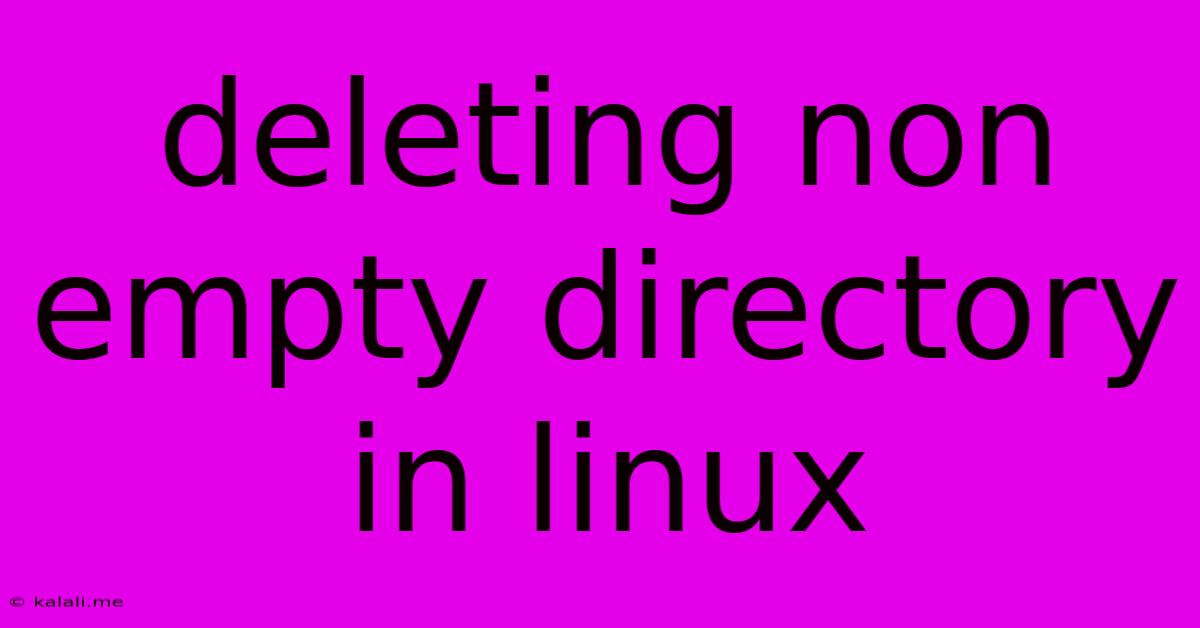Deleting Non Empty Directory In Linux
Kalali
Jun 01, 2025 · 3 min read

Table of Contents
Deleting Non-Empty Directories in Linux: A Comprehensive Guide
Deleting a directory in Linux is a common task, but it's not always straightforward. While removing an empty directory is a simple rmdir command, deleting a non-empty directory requires a different approach. This guide will cover various methods, highlighting their advantages and disadvantages, ensuring you can choose the best technique for your situation. We'll explore the safest methods to avoid accidental data loss and explain how to handle potential issues.
Understanding the Challenge: Why rmdir Won't Work
The rmdir command in Linux is designed specifically for removing empty directories. Attempting to use it on a directory containing files or subdirectories will result in an error message. This is a crucial safety feature, preventing accidental deletion of important data. Therefore, we need alternative commands to handle non-empty directories.
Methods for Deleting Non-Empty Directories
Here are the most common and effective methods for deleting non-empty directories in Linux:
1. Using rm -r (Recursive Removal):
The rm -r command, or its equivalent rm -R, is the most frequently used method. The -r (or -R) flag stands for "recursive," instructing the command to delete the directory and all its contents, including files and subdirectories, without prompting for confirmation.
Syntax: sudo rm -rf <directory_name>
sudo: This is crucial for deleting directories you don't own, requiring administrator privileges.rm: The command for removing files and directories.-ror-R: The recursive flag, essential for deleting non-empty directories.-f: (Optional) This force flag bypasses confirmation prompts, making the deletion immediate. Use this with extreme caution, as it leaves no room for error.<directory_name>: The path to the directory you want to delete.
Example: sudo rm -rf /path/to/my/directory
Caution: rm -rf is powerful and irreversible. Always double-check the directory path before executing this command to avoid accidental data loss.
2. Using rm -i (Interactive Removal):
For a safer approach, especially when deleting directories with many files, use the -i flag for interactive removal. This prompts you for confirmation before deleting each file and directory.
Syntax: sudo rm -ir <directory_name>
Example: sudo rm -ir /path/to/my/directory
This method offers a layer of protection against accidental deletion, but it can be time-consuming for large directories.
3. Using find and xargs for more granular control:**
For complex scenarios or when you need more fine-grained control over the deletion process, combining find and xargs is a powerful solution. This allows for specific criteria to be met before deletion, such as file type or age.
Syntax: find <directory_name> -type d -exec rm -rf {} \; (This will delete all directories and their content within the specified directory).
For removing specific file types, add further filters. For example:
find <directory_name> -type f -name "*.log" -exec rm -rf {} \; (deletes all .log files).
Example: find /path/to/my/directory -type d -exec rm -rf {} \;
4. Manually Deleting Files and then the Directory (Safest Method):
The safest approach, though the most time-consuming, is to manually delete the contents of the directory using rm (without the -r flag) and then removing the now-empty directory using rmdir. This offers maximum control and minimizes the risk of accidental data loss.
Best Practices and Safety Tips
- Always back up your data before deleting anything important. This is crucial, especially when dealing with
rm -rf. - Double-check the directory path before executing any delete command. A simple typo can lead to catastrophic data loss.
- Use the interactive
-iflag whenever possible to avoid accidental deletion. - Consider using a version control system (like Git) to manage your files and easily recover from accidental deletions.
- Understand the commands before you use them. Rushing can lead to irreversible mistakes.
By understanding these methods and following these best practices, you can confidently delete non-empty directories in Linux while minimizing the risk of data loss and ensuring a smooth workflow. Remember, prevention is always better than cure when dealing with irreversible commands.
Latest Posts
Latest Posts
-
Can U Lay A Fridge On Its Back
Jun 02, 2025
-
How To Install A Prehung Interior Door
Jun 02, 2025
-
Can You Take Your Own Pieces In Chess
Jun 02, 2025
-
How To Lower Power Lines On Map
Jun 02, 2025
-
Canon A1 Mis Aligned Frame Counters
Jun 02, 2025
Related Post
Thank you for visiting our website which covers about Deleting Non Empty Directory In Linux . We hope the information provided has been useful to you. Feel free to contact us if you have any questions or need further assistance. See you next time and don't miss to bookmark.